University Assignment: PSY302 - Race, Biology, and Social Construction
VerifiedAdded on 2023/01/19
|14
|3840
|97
Essay
AI Summary
This essay critically evaluates the debate surrounding the biological basis versus the social construction of race. It begins by exploring the historical perception of race as a biological attribute, contrasting it with the contemporary view that race is a social construct. The essay delves into the social constructionism view, emphasizing how race is a product of societal practices and power dynamics. It examines the role of social learning theory, cultural transmission, and cognitive mechanisms in shaping racial concepts. The discussion includes the influence of environmental biases, prejudice, and the role of prestige in the acquisition of racial ideas. Furthermore, it highlights the significance of the Self-Categorization Theory (SCT) and the way individuals categorize the world into different social categories. The essay also touches on the role of ethnic cognition and the recurrence of racialism across cultures, concluding with a framework that combines social constructionist and evolutionary cognitive approaches to understanding race.
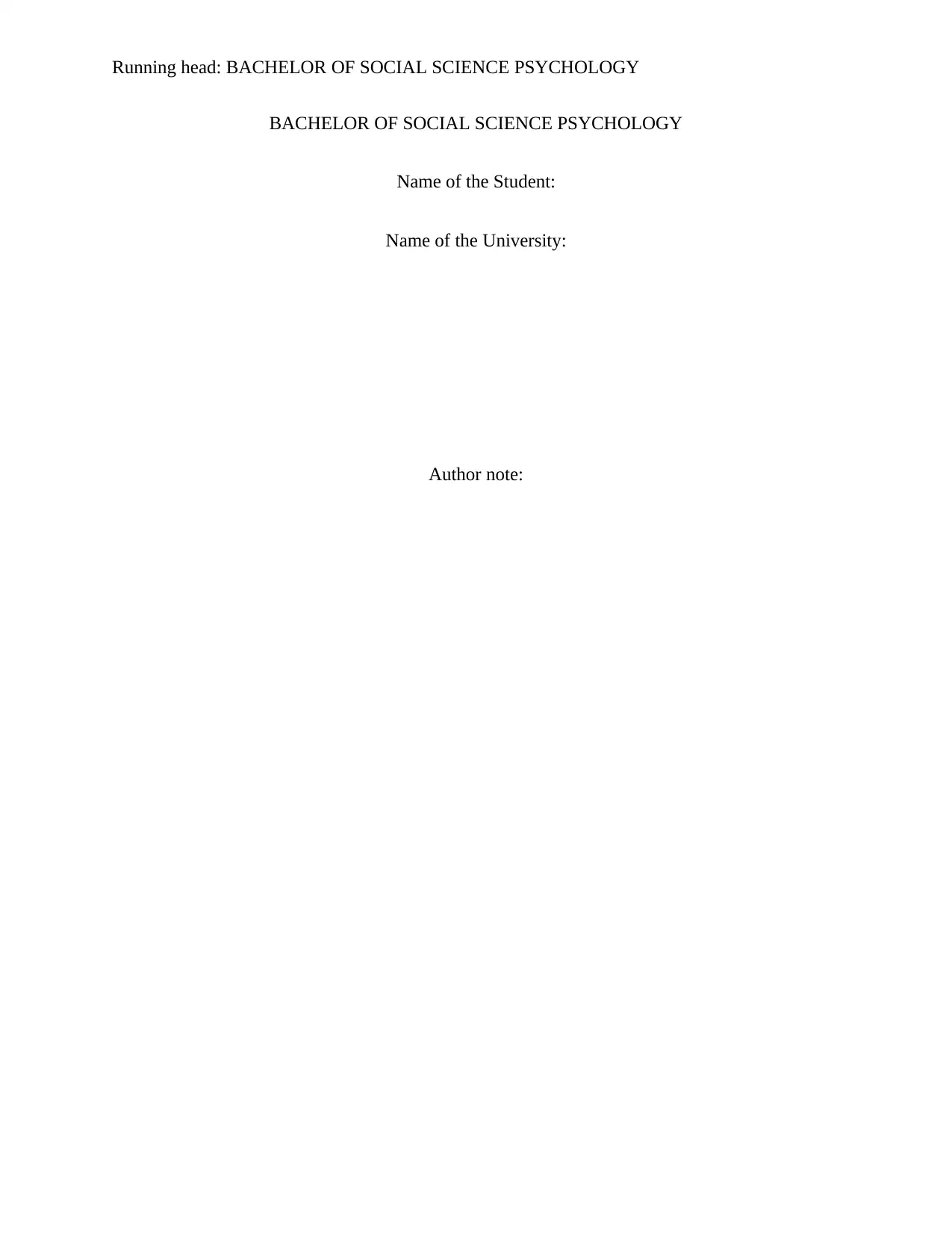
Running head: BACHELOR OF SOCIAL SCIENCE PSYCHOLOGY
BACHELOR OF SOCIAL SCIENCE PSYCHOLOGY
Name of the Student:
Name of the University:
Author note:
BACHELOR OF SOCIAL SCIENCE PSYCHOLOGY
Name of the Student:
Name of the University:
Author note:
Paraphrase This Document
Need a fresh take? Get an instant paraphrase of this document with our AI Paraphraser
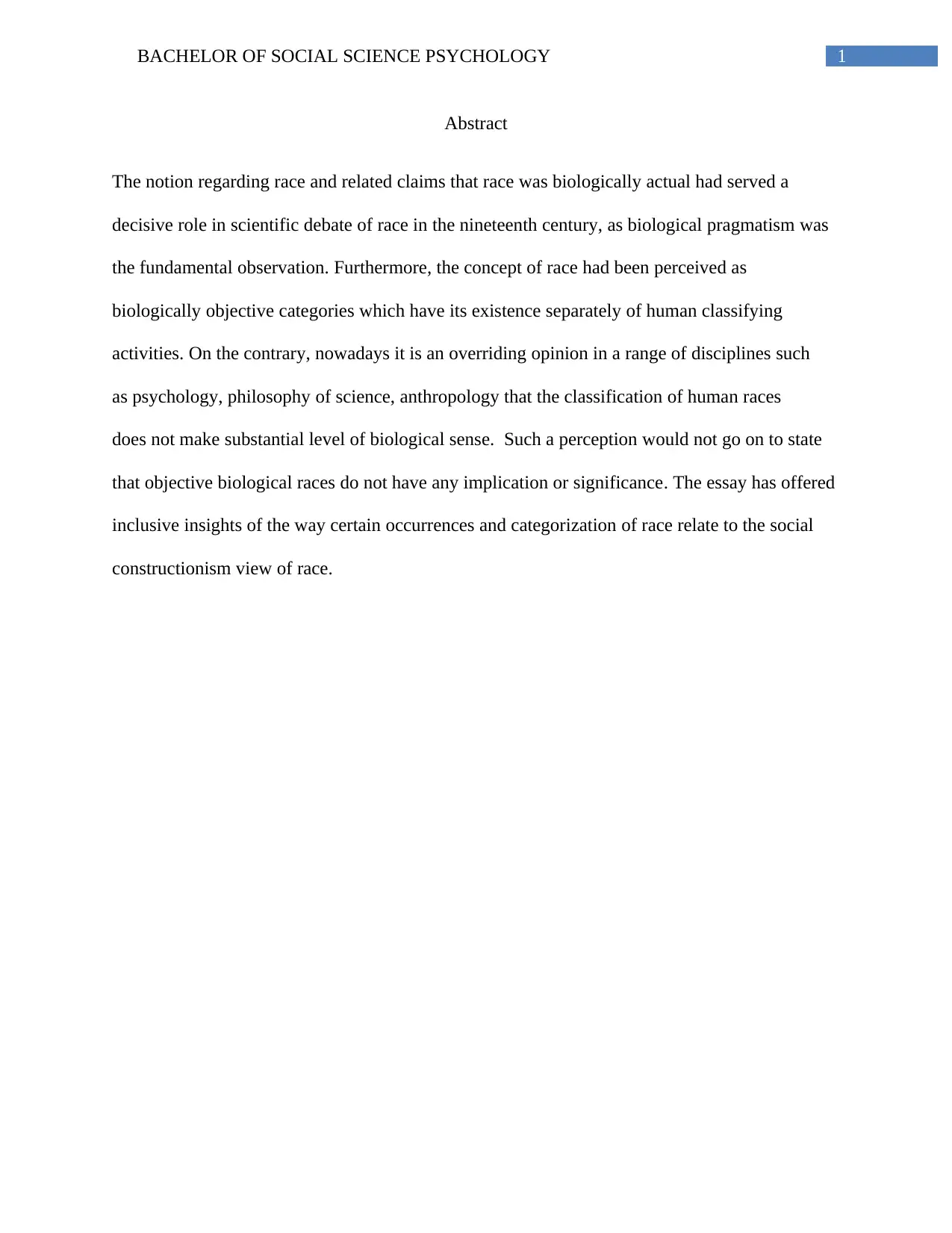
1BACHELOR OF SOCIAL SCIENCE PSYCHOLOGY
Abstract
The notion regarding race and related claims that race was biologically actual had served a
decisive role in scientific debate of race in the nineteenth century, as biological pragmatism was
the fundamental observation. Furthermore, the concept of race had been perceived as
biologically objective categories which have its existence separately of human classifying
activities. On the contrary, nowadays it is an overriding opinion in a range of disciplines such
as psychology, philosophy of science, anthropology that the classification of human races
does not make substantial level of biological sense. Such a perception would not go on to state
that objective biological races do not have any implication or significance. The essay has offered
inclusive insights of the way certain occurrences and categorization of race relate to the social
constructionism view of race.
Abstract
The notion regarding race and related claims that race was biologically actual had served a
decisive role in scientific debate of race in the nineteenth century, as biological pragmatism was
the fundamental observation. Furthermore, the concept of race had been perceived as
biologically objective categories which have its existence separately of human classifying
activities. On the contrary, nowadays it is an overriding opinion in a range of disciplines such
as psychology, philosophy of science, anthropology that the classification of human races
does not make substantial level of biological sense. Such a perception would not go on to state
that objective biological races do not have any implication or significance. The essay has offered
inclusive insights of the way certain occurrences and categorization of race relate to the social
constructionism view of race.
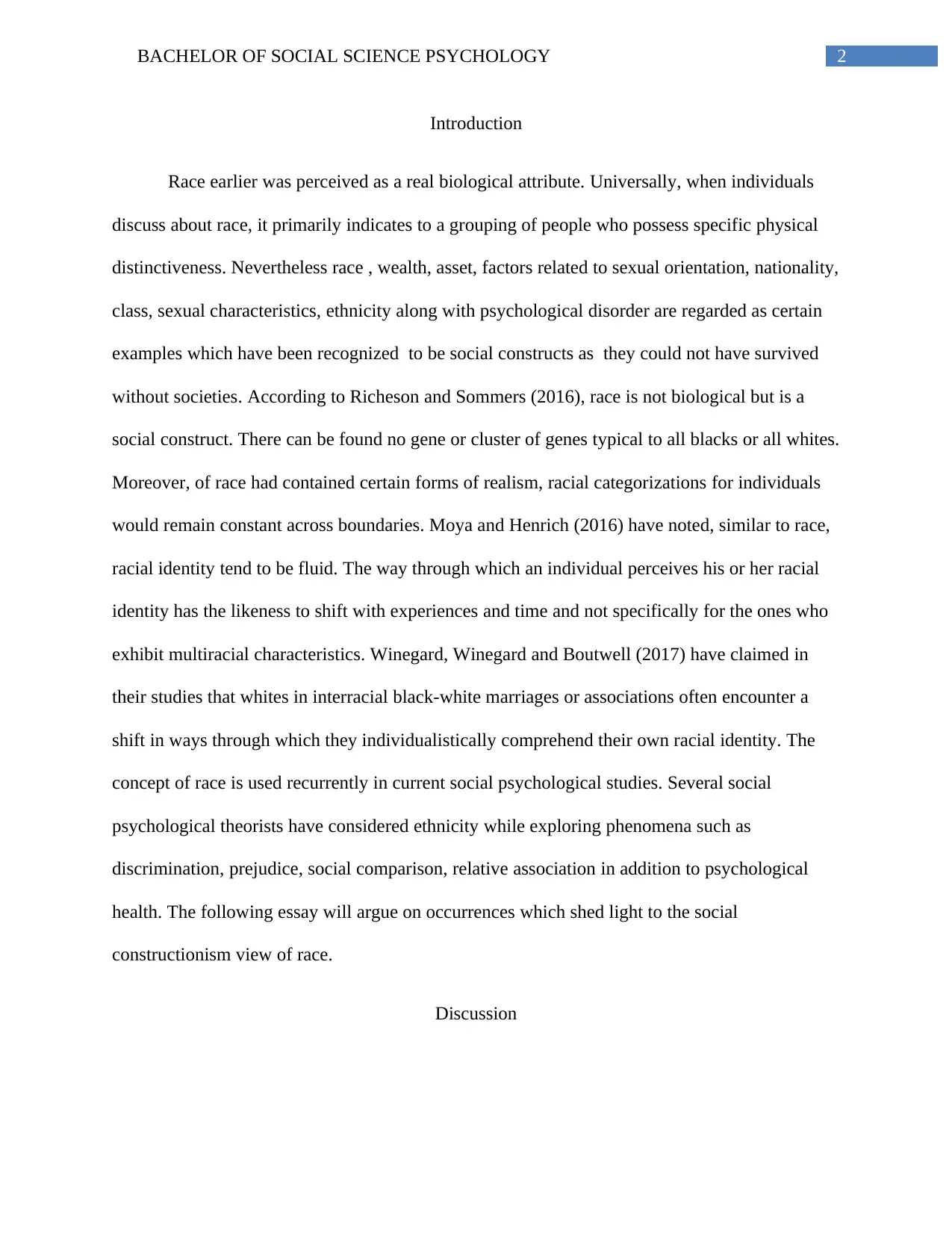
2BACHELOR OF SOCIAL SCIENCE PSYCHOLOGY
Introduction
Race earlier was perceived as a real biological attribute. Universally, when individuals
discuss about race, it primarily indicates to a grouping of people who possess specific physical
distinctiveness. Nevertheless race , wealth, asset, factors related to sexual orientation, nationality,
class, sexual characteristics, ethnicity along with psychological disorder are regarded as certain
examples which have been recognized to be social constructs as they could not have survived
without societies. According to Richeson and Sommers (2016), race is not biological but is a
social construct. There can be found no gene or cluster of genes typical to all blacks or all whites.
Moreover, of race had contained certain forms of realism, racial categorizations for individuals
would remain constant across boundaries. Moya and Henrich (2016) have noted, similar to race,
racial identity tend to be fluid. The way through which an individual perceives his or her racial
identity has the likeness to shift with experiences and time and not specifically for the ones who
exhibit multiracial characteristics. Winegard, Winegard and Boutwell (2017) have claimed in
their studies that whites in interracial black-white marriages or associations often encounter a
shift in ways through which they individualistically comprehend their own racial identity. The
concept of race is used recurrently in current social psychological studies. Several social
psychological theorists have considered ethnicity while exploring phenomena such as
discrimination, prejudice, social comparison, relative association in addition to psychological
health. The following essay will argue on occurrences which shed light to the social
constructionism view of race.
Discussion
Introduction
Race earlier was perceived as a real biological attribute. Universally, when individuals
discuss about race, it primarily indicates to a grouping of people who possess specific physical
distinctiveness. Nevertheless race , wealth, asset, factors related to sexual orientation, nationality,
class, sexual characteristics, ethnicity along with psychological disorder are regarded as certain
examples which have been recognized to be social constructs as they could not have survived
without societies. According to Richeson and Sommers (2016), race is not biological but is a
social construct. There can be found no gene or cluster of genes typical to all blacks or all whites.
Moreover, of race had contained certain forms of realism, racial categorizations for individuals
would remain constant across boundaries. Moya and Henrich (2016) have noted, similar to race,
racial identity tend to be fluid. The way through which an individual perceives his or her racial
identity has the likeness to shift with experiences and time and not specifically for the ones who
exhibit multiracial characteristics. Winegard, Winegard and Boutwell (2017) have claimed in
their studies that whites in interracial black-white marriages or associations often encounter a
shift in ways through which they individualistically comprehend their own racial identity. The
concept of race is used recurrently in current social psychological studies. Several social
psychological theorists have considered ethnicity while exploring phenomena such as
discrimination, prejudice, social comparison, relative association in addition to psychological
health. The following essay will argue on occurrences which shed light to the social
constructionism view of race.
Discussion
⊘ This is a preview!⊘
Do you want full access?
Subscribe today to unlock all pages.

Trusted by 1+ million students worldwide
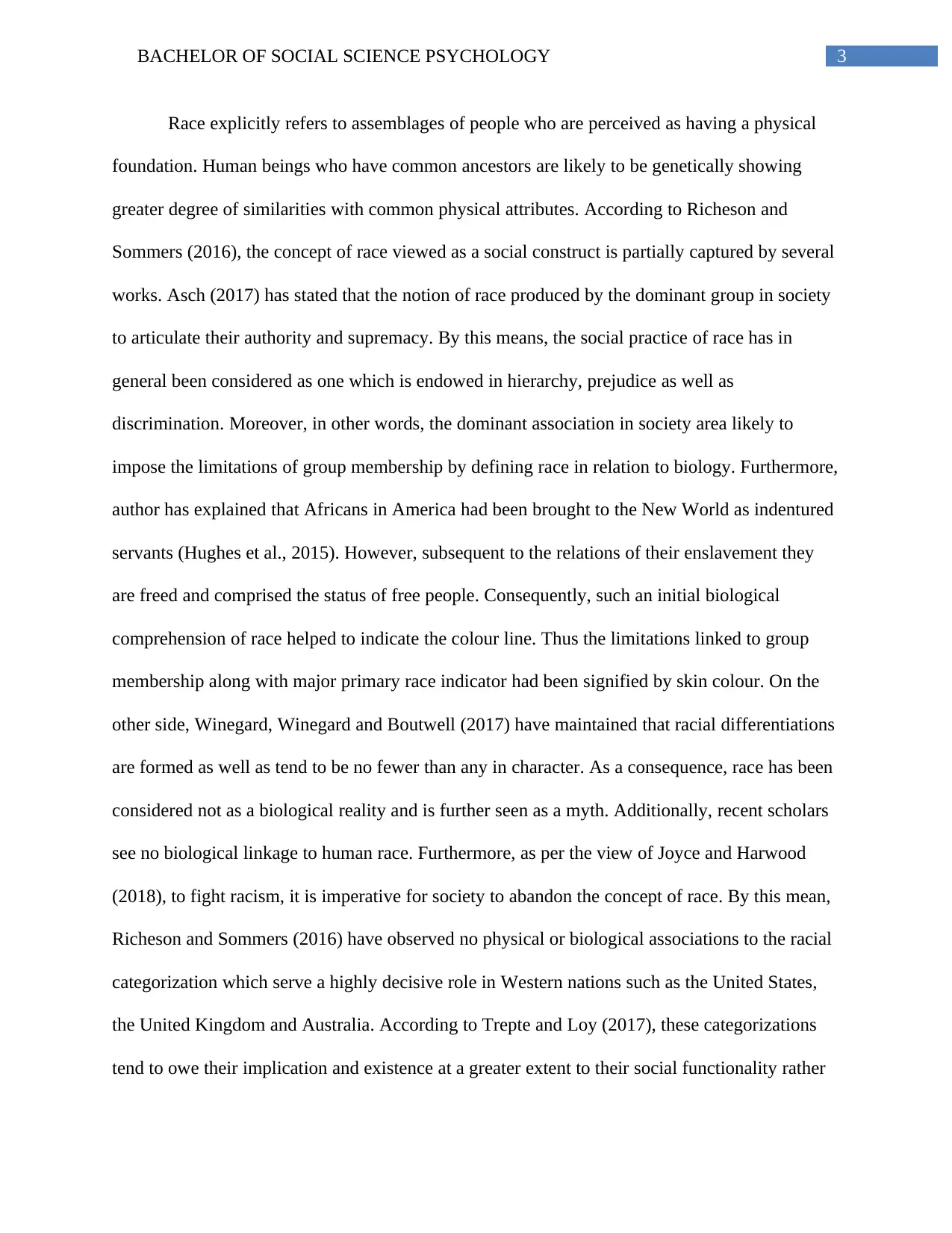
3BACHELOR OF SOCIAL SCIENCE PSYCHOLOGY
Race explicitly refers to assemblages of people who are perceived as having a physical
foundation. Human beings who have common ancestors are likely to be genetically showing
greater degree of similarities with common physical attributes. According to Richeson and
Sommers (2016), the concept of race viewed as a social construct is partially captured by several
works. Asch (2017) has stated that the notion of race produced by the dominant group in society
to articulate their authority and supremacy. By this means, the social practice of race has in
general been considered as one which is endowed in hierarchy, prejudice as well as
discrimination. Moreover, in other words, the dominant association in society area likely to
impose the limitations of group membership by defining race in relation to biology. Furthermore,
author has explained that Africans in America had been brought to the New World as indentured
servants (Hughes et al., 2015). However, subsequent to the relations of their enslavement they
are freed and comprised the status of free people. Consequently, such an initial biological
comprehension of race helped to indicate the colour line. Thus the limitations linked to group
membership along with major primary race indicator had been signified by skin colour. On the
other side, Winegard, Winegard and Boutwell (2017) have maintained that racial differentiations
are formed as well as tend to be no fewer than any in character. As a consequence, race has been
considered not as a biological reality and is further seen as a myth. Additionally, recent scholars
see no biological linkage to human race. Furthermore, as per the view of Joyce and Harwood
(2018), to fight racism, it is imperative for society to abandon the concept of race. By this mean,
Richeson and Sommers (2016) have observed no physical or biological associations to the racial
categorization which serve a highly decisive role in Western nations such as the United States,
the United Kingdom and Australia. According to Trepte and Loy (2017), these categorizations
tend to owe their implication and existence at a greater extent to their social functionality rather
Race explicitly refers to assemblages of people who are perceived as having a physical
foundation. Human beings who have common ancestors are likely to be genetically showing
greater degree of similarities with common physical attributes. According to Richeson and
Sommers (2016), the concept of race viewed as a social construct is partially captured by several
works. Asch (2017) has stated that the notion of race produced by the dominant group in society
to articulate their authority and supremacy. By this means, the social practice of race has in
general been considered as one which is endowed in hierarchy, prejudice as well as
discrimination. Moreover, in other words, the dominant association in society area likely to
impose the limitations of group membership by defining race in relation to biology. Furthermore,
author has explained that Africans in America had been brought to the New World as indentured
servants (Hughes et al., 2015). However, subsequent to the relations of their enslavement they
are freed and comprised the status of free people. Consequently, such an initial biological
comprehension of race helped to indicate the colour line. Thus the limitations linked to group
membership along with major primary race indicator had been signified by skin colour. On the
other side, Winegard, Winegard and Boutwell (2017) have maintained that racial differentiations
are formed as well as tend to be no fewer than any in character. As a consequence, race has been
considered not as a biological reality and is further seen as a myth. Additionally, recent scholars
see no biological linkage to human race. Furthermore, as per the view of Joyce and Harwood
(2018), to fight racism, it is imperative for society to abandon the concept of race. By this mean,
Richeson and Sommers (2016) have observed no physical or biological associations to the racial
categorization which serve a highly decisive role in Western nations such as the United States,
the United Kingdom and Australia. According to Trepte and Loy (2017), these categorizations
tend to owe their implication and existence at a greater extent to their social functionality rather
Paraphrase This Document
Need a fresh take? Get an instant paraphrase of this document with our AI Paraphraser
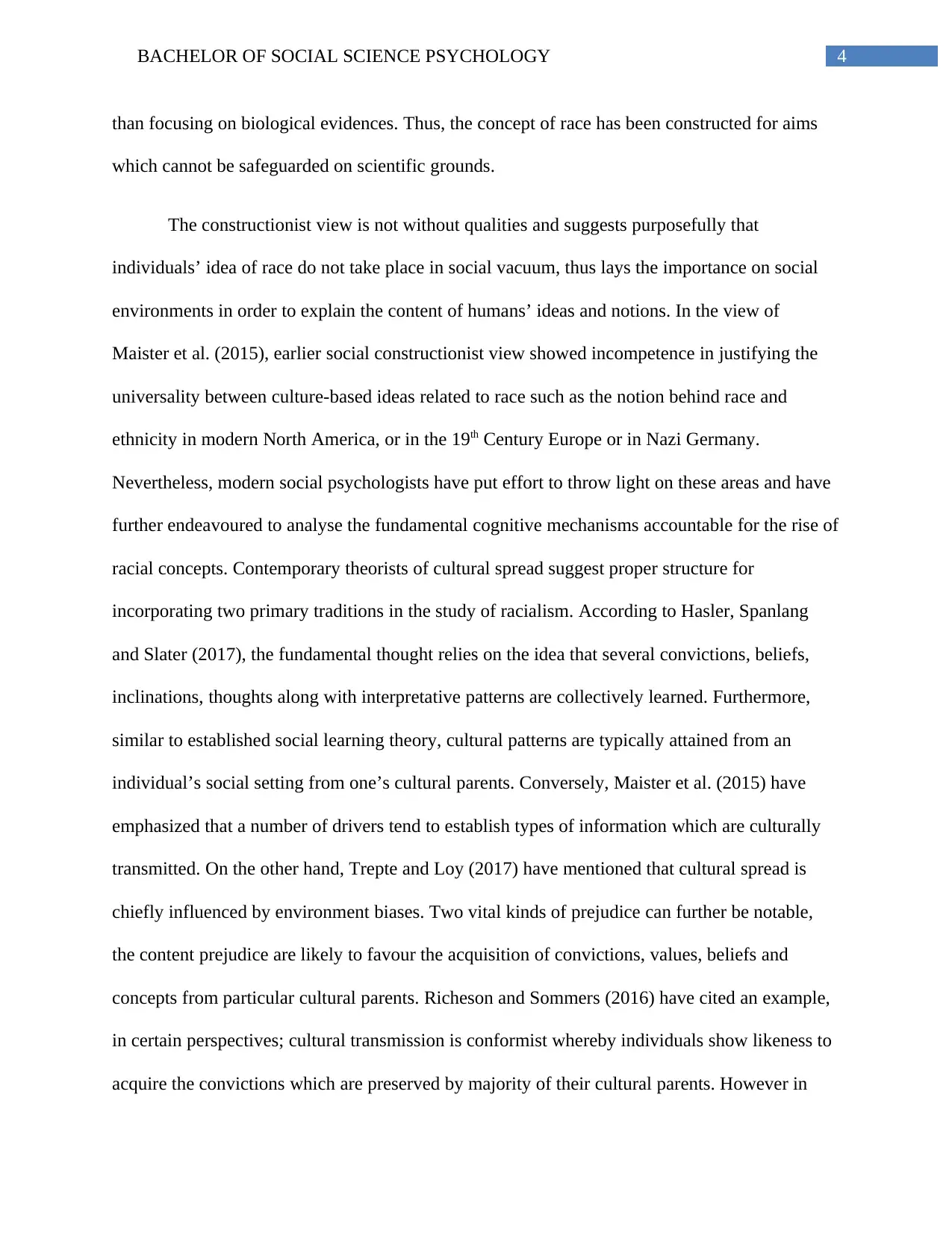
4BACHELOR OF SOCIAL SCIENCE PSYCHOLOGY
than focusing on biological evidences. Thus, the concept of race has been constructed for aims
which cannot be safeguarded on scientific grounds.
The constructionist view is not without qualities and suggests purposefully that
individuals’ idea of race do not take place in social vacuum, thus lays the importance on social
environments in order to explain the content of humans’ ideas and notions. In the view of
Maister et al. (2015), earlier social constructionist view showed incompetence in justifying the
universality between culture-based ideas related to race such as the notion behind race and
ethnicity in modern North America, or in the 19th Century Europe or in Nazi Germany.
Nevertheless, modern social psychologists have put effort to throw light on these areas and have
further endeavoured to analyse the fundamental cognitive mechanisms accountable for the rise of
racial concepts. Contemporary theorists of cultural spread suggest proper structure for
incorporating two primary traditions in the study of racialism. According to Hasler, Spanlang
and Slater (2017), the fundamental thought relies on the idea that several convictions, beliefs,
inclinations, thoughts along with interpretative patterns are collectively learned. Furthermore,
similar to established social learning theory, cultural patterns are typically attained from an
individual’s social setting from one’s cultural parents. Conversely, Maister et al. (2015) have
emphasized that a number of drivers tend to establish types of information which are culturally
transmitted. On the other hand, Trepte and Loy (2017) have mentioned that cultural spread is
chiefly influenced by environment biases. Two vital kinds of prejudice can further be notable,
the content prejudice are likely to favour the acquisition of convictions, values, beliefs and
concepts from particular cultural parents. Richeson and Sommers (2016) have cited an example,
in certain perspectives; cultural transmission is conformist whereby individuals show likeness to
acquire the convictions which are preserved by majority of their cultural parents. However in
than focusing on biological evidences. Thus, the concept of race has been constructed for aims
which cannot be safeguarded on scientific grounds.
The constructionist view is not without qualities and suggests purposefully that
individuals’ idea of race do not take place in social vacuum, thus lays the importance on social
environments in order to explain the content of humans’ ideas and notions. In the view of
Maister et al. (2015), earlier social constructionist view showed incompetence in justifying the
universality between culture-based ideas related to race such as the notion behind race and
ethnicity in modern North America, or in the 19th Century Europe or in Nazi Germany.
Nevertheless, modern social psychologists have put effort to throw light on these areas and have
further endeavoured to analyse the fundamental cognitive mechanisms accountable for the rise of
racial concepts. Contemporary theorists of cultural spread suggest proper structure for
incorporating two primary traditions in the study of racialism. According to Hasler, Spanlang
and Slater (2017), the fundamental thought relies on the idea that several convictions, beliefs,
inclinations, thoughts along with interpretative patterns are collectively learned. Furthermore,
similar to established social learning theory, cultural patterns are typically attained from an
individual’s social setting from one’s cultural parents. Conversely, Maister et al. (2015) have
emphasized that a number of drivers tend to establish types of information which are culturally
transmitted. On the other hand, Trepte and Loy (2017) have mentioned that cultural spread is
chiefly influenced by environment biases. Two vital kinds of prejudice can further be notable,
the content prejudice are likely to favour the acquisition of convictions, values, beliefs and
concepts from particular cultural parents. Richeson and Sommers (2016) have cited an example,
in certain perspectives; cultural transmission is conformist whereby individuals show likeness to
acquire the convictions which are preserved by majority of their cultural parents. However in
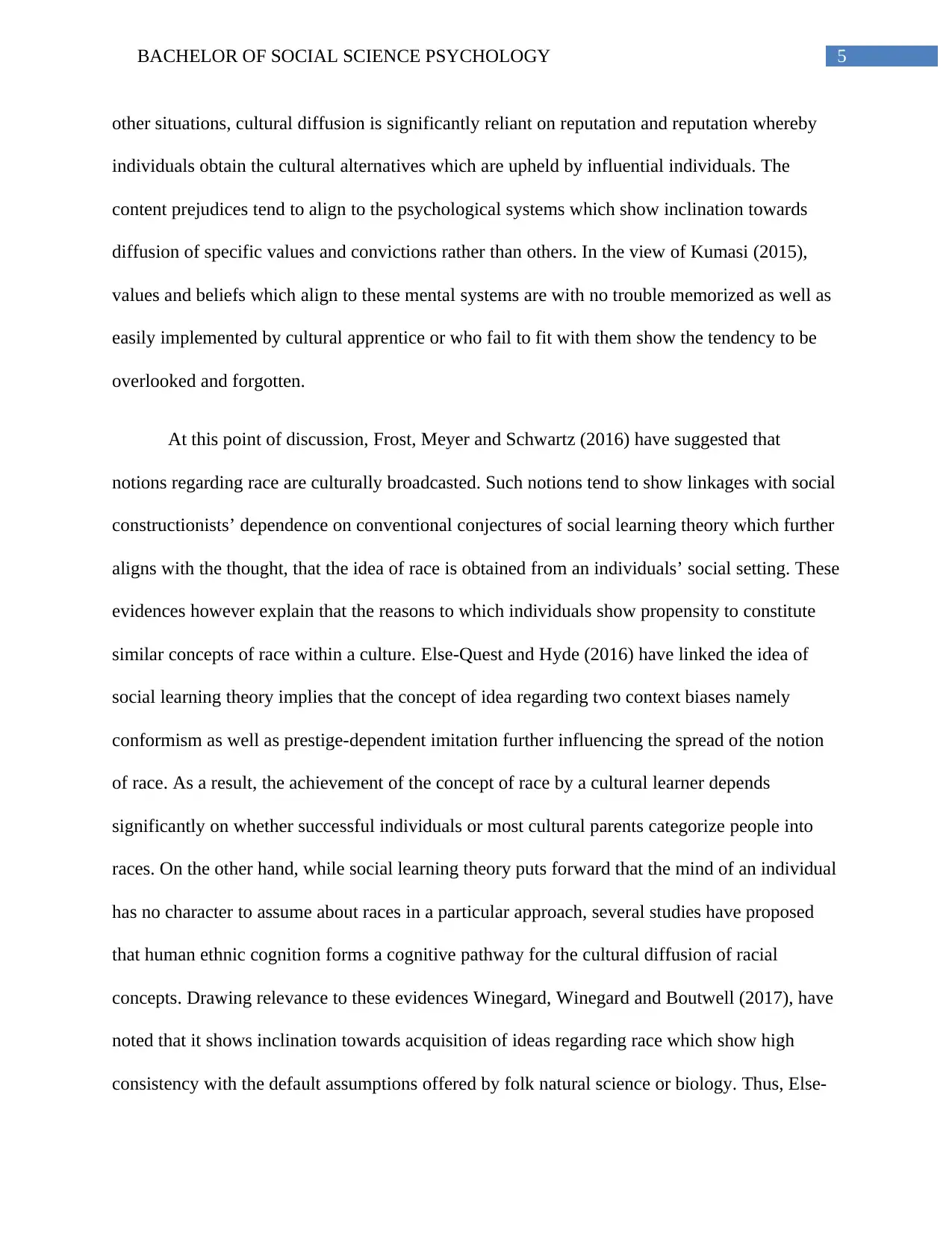
5BACHELOR OF SOCIAL SCIENCE PSYCHOLOGY
other situations, cultural diffusion is significantly reliant on reputation and reputation whereby
individuals obtain the cultural alternatives which are upheld by influential individuals. The
content prejudices tend to align to the psychological systems which show inclination towards
diffusion of specific values and convictions rather than others. In the view of Kumasi (2015),
values and beliefs which align to these mental systems are with no trouble memorized as well as
easily implemented by cultural apprentice or who fail to fit with them show the tendency to be
overlooked and forgotten.
At this point of discussion, Frost, Meyer and Schwartz (2016) have suggested that
notions regarding race are culturally broadcasted. Such notions tend to show linkages with social
constructionists’ dependence on conventional conjectures of social learning theory which further
aligns with the thought, that the idea of race is obtained from an individuals’ social setting. These
evidences however explain that the reasons to which individuals show propensity to constitute
similar concepts of race within a culture. Else-Quest and Hyde (2016) have linked the idea of
social learning theory implies that the concept of idea regarding two context biases namely
conformism as well as prestige-dependent imitation further influencing the spread of the notion
of race. As a result, the achievement of the concept of race by a cultural learner depends
significantly on whether successful individuals or most cultural parents categorize people into
races. On the other hand, while social learning theory puts forward that the mind of an individual
has no character to assume about races in a particular approach, several studies have proposed
that human ethnic cognition forms a cognitive pathway for the cultural diffusion of racial
concepts. Drawing relevance to these evidences Winegard, Winegard and Boutwell (2017), have
noted that it shows inclination towards acquisition of ideas regarding race which show high
consistency with the default assumptions offered by folk natural science or biology. Thus, Else-
other situations, cultural diffusion is significantly reliant on reputation and reputation whereby
individuals obtain the cultural alternatives which are upheld by influential individuals. The
content prejudices tend to align to the psychological systems which show inclination towards
diffusion of specific values and convictions rather than others. In the view of Kumasi (2015),
values and beliefs which align to these mental systems are with no trouble memorized as well as
easily implemented by cultural apprentice or who fail to fit with them show the tendency to be
overlooked and forgotten.
At this point of discussion, Frost, Meyer and Schwartz (2016) have suggested that
notions regarding race are culturally broadcasted. Such notions tend to show linkages with social
constructionists’ dependence on conventional conjectures of social learning theory which further
aligns with the thought, that the idea of race is obtained from an individuals’ social setting. These
evidences however explain that the reasons to which individuals show propensity to constitute
similar concepts of race within a culture. Else-Quest and Hyde (2016) have linked the idea of
social learning theory implies that the concept of idea regarding two context biases namely
conformism as well as prestige-dependent imitation further influencing the spread of the notion
of race. As a result, the achievement of the concept of race by a cultural learner depends
significantly on whether successful individuals or most cultural parents categorize people into
races. On the other hand, while social learning theory puts forward that the mind of an individual
has no character to assume about races in a particular approach, several studies have proposed
that human ethnic cognition forms a cognitive pathway for the cultural diffusion of racial
concepts. Drawing relevance to these evidences Winegard, Winegard and Boutwell (2017), have
noted that it shows inclination towards acquisition of ideas regarding race which show high
consistency with the default assumptions offered by folk natural science or biology. Thus, Else-
⊘ This is a preview!⊘
Do you want full access?
Subscribe today to unlock all pages.

Trusted by 1+ million students worldwide
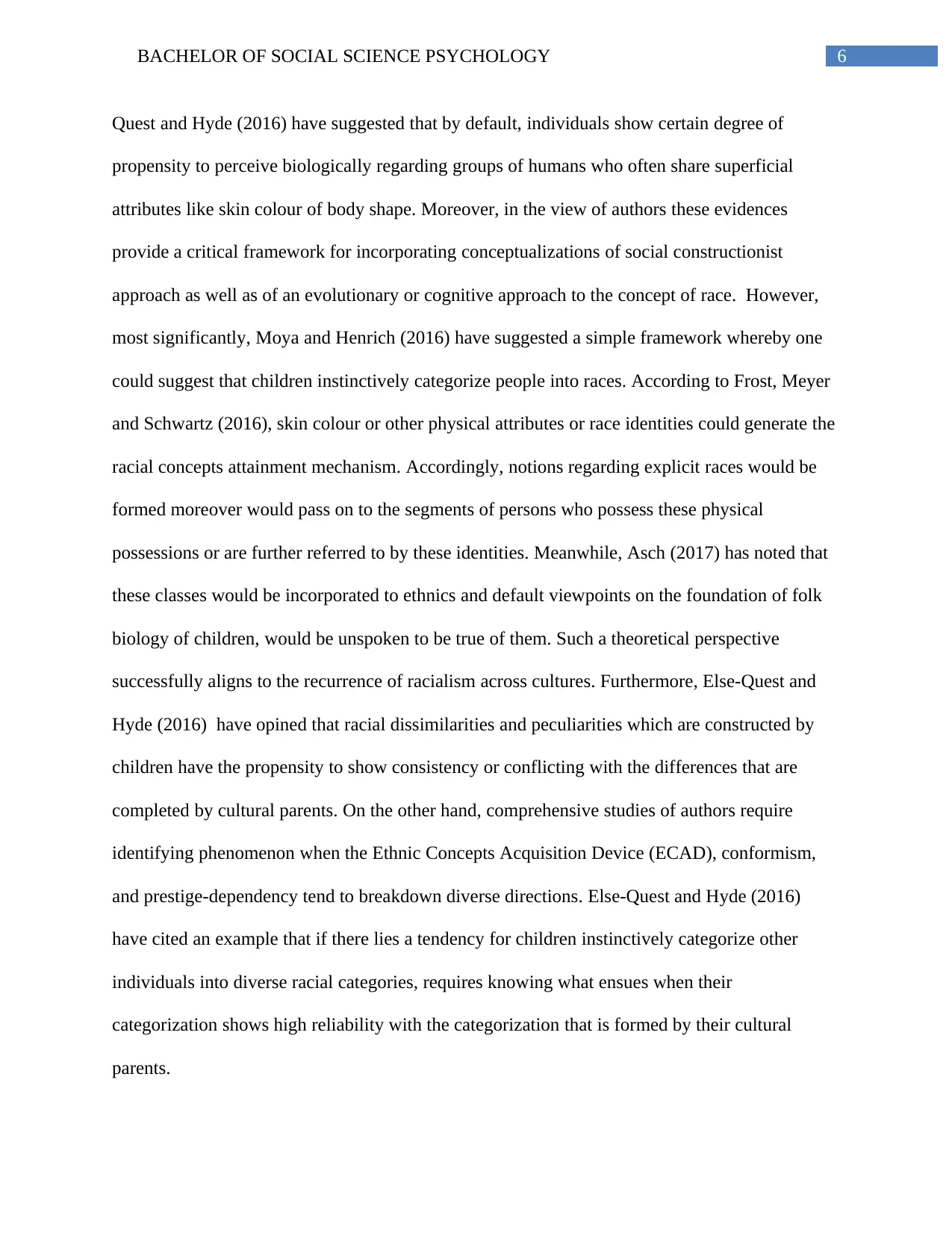
6BACHELOR OF SOCIAL SCIENCE PSYCHOLOGY
Quest and Hyde (2016) have suggested that by default, individuals show certain degree of
propensity to perceive biologically regarding groups of humans who often share superficial
attributes like skin colour of body shape. Moreover, in the view of authors these evidences
provide a critical framework for incorporating conceptualizations of social constructionist
approach as well as of an evolutionary or cognitive approach to the concept of race. However,
most significantly, Moya and Henrich (2016) have suggested a simple framework whereby one
could suggest that children instinctively categorize people into races. According to Frost, Meyer
and Schwartz (2016), skin colour or other physical attributes or race identities could generate the
racial concepts attainment mechanism. Accordingly, notions regarding explicit races would be
formed moreover would pass on to the segments of persons who possess these physical
possessions or are further referred to by these identities. Meanwhile, Asch (2017) has noted that
these classes would be incorporated to ethnics and default viewpoints on the foundation of folk
biology of children, would be unspoken to be true of them. Such a theoretical perspective
successfully aligns to the recurrence of racialism across cultures. Furthermore, Else-Quest and
Hyde (2016) have opined that racial dissimilarities and peculiarities which are constructed by
children have the propensity to show consistency or conflicting with the differences that are
completed by cultural parents. On the other hand, comprehensive studies of authors require
identifying phenomenon when the Ethnic Concepts Acquisition Device (ECAD), conformism,
and prestige-dependency tend to breakdown diverse directions. Else-Quest and Hyde (2016)
have cited an example that if there lies a tendency for children instinctively categorize other
individuals into diverse racial categories, requires knowing what ensues when their
categorization shows high reliability with the categorization that is formed by their cultural
parents.
Quest and Hyde (2016) have suggested that by default, individuals show certain degree of
propensity to perceive biologically regarding groups of humans who often share superficial
attributes like skin colour of body shape. Moreover, in the view of authors these evidences
provide a critical framework for incorporating conceptualizations of social constructionist
approach as well as of an evolutionary or cognitive approach to the concept of race. However,
most significantly, Moya and Henrich (2016) have suggested a simple framework whereby one
could suggest that children instinctively categorize people into races. According to Frost, Meyer
and Schwartz (2016), skin colour or other physical attributes or race identities could generate the
racial concepts attainment mechanism. Accordingly, notions regarding explicit races would be
formed moreover would pass on to the segments of persons who possess these physical
possessions or are further referred to by these identities. Meanwhile, Asch (2017) has noted that
these classes would be incorporated to ethnics and default viewpoints on the foundation of folk
biology of children, would be unspoken to be true of them. Such a theoretical perspective
successfully aligns to the recurrence of racialism across cultures. Furthermore, Else-Quest and
Hyde (2016) have opined that racial dissimilarities and peculiarities which are constructed by
children have the propensity to show consistency or conflicting with the differences that are
completed by cultural parents. On the other hand, comprehensive studies of authors require
identifying phenomenon when the Ethnic Concepts Acquisition Device (ECAD), conformism,
and prestige-dependency tend to breakdown diverse directions. Else-Quest and Hyde (2016)
have cited an example that if there lies a tendency for children instinctively categorize other
individuals into diverse racial categories, requires knowing what ensues when their
categorization shows high reliability with the categorization that is formed by their cultural
parents.
Paraphrase This Document
Need a fresh take? Get an instant paraphrase of this document with our AI Paraphraser
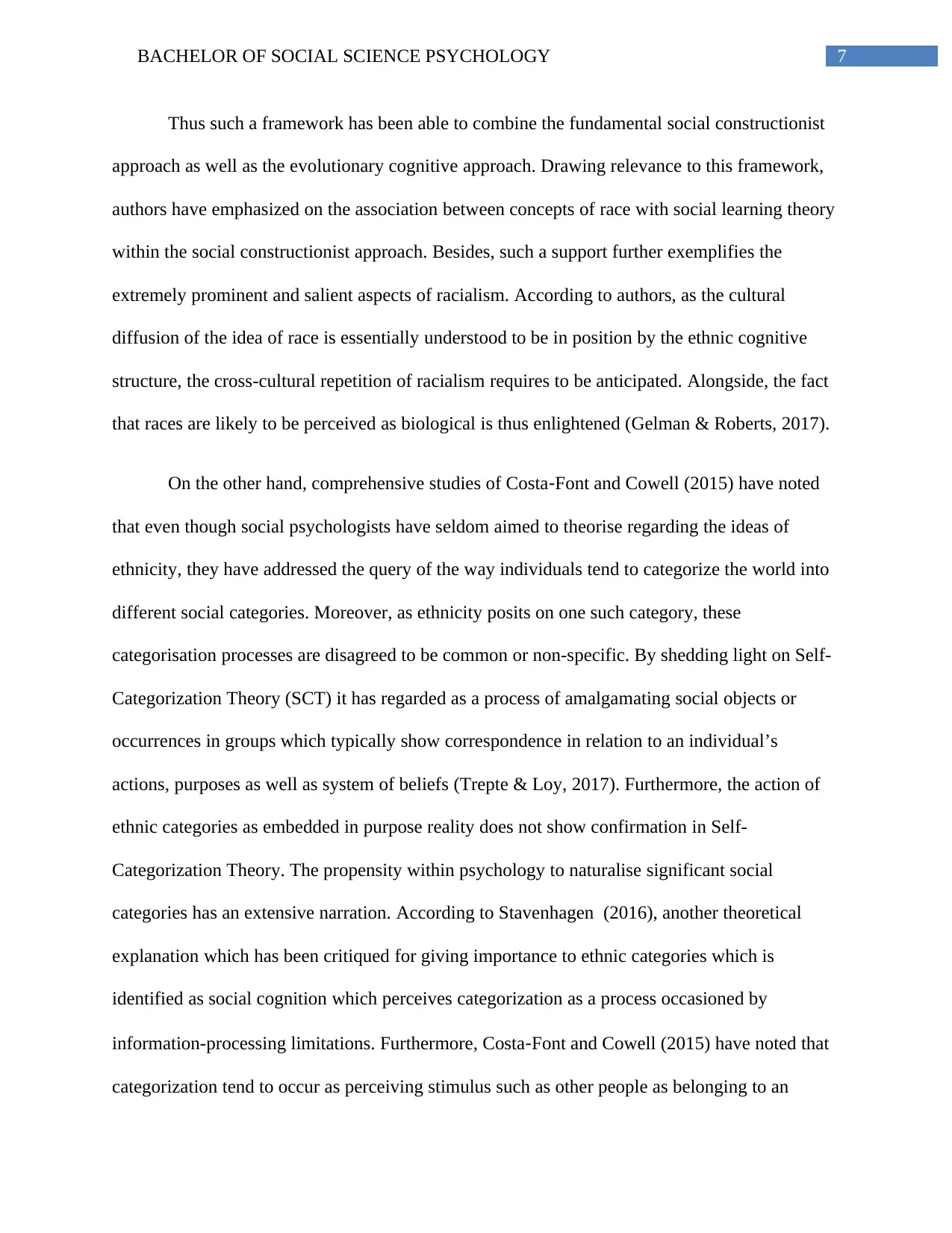
7BACHELOR OF SOCIAL SCIENCE PSYCHOLOGY
Thus such a framework has been able to combine the fundamental social constructionist
approach as well as the evolutionary cognitive approach. Drawing relevance to this framework,
authors have emphasized on the association between concepts of race with social learning theory
within the social constructionist approach. Besides, such a support further exemplifies the
extremely prominent and salient aspects of racialism. According to authors, as the cultural
diffusion of the idea of race is essentially understood to be in position by the ethnic cognitive
structure, the cross-cultural repetition of racialism requires to be anticipated. Alongside, the fact
that races are likely to be perceived as biological is thus enlightened (Gelman & Roberts, 2017).
On the other hand, comprehensive studies of Costa‐Font and Cowell (2015) have noted
that even though social psychologists have seldom aimed to theorise regarding the ideas of
ethnicity, they have addressed the query of the way individuals tend to categorize the world into
different social categories. Moreover, as ethnicity posits on one such category, these
categorisation processes are disagreed to be common or non-specific. By shedding light on Self-
Categorization Theory (SCT) it has regarded as a process of amalgamating social objects or
occurrences in groups which typically show correspondence in relation to an individual’s
actions, purposes as well as system of beliefs (Trepte & Loy, 2017). Furthermore, the action of
ethnic categories as embedded in purpose reality does not show confirmation in Self-
Categorization Theory. The propensity within psychology to naturalise significant social
categories has an extensive narration. According to Stavenhagen (2016), another theoretical
explanation which has been critiqued for giving importance to ethnic categories which is
identified as social cognition which perceives categorization as a process occasioned by
information-processing limitations. Furthermore, Costa‐Font and Cowell (2015) have noted that
categorization tend to occur as perceiving stimulus such as other people as belonging to an
Thus such a framework has been able to combine the fundamental social constructionist
approach as well as the evolutionary cognitive approach. Drawing relevance to this framework,
authors have emphasized on the association between concepts of race with social learning theory
within the social constructionist approach. Besides, such a support further exemplifies the
extremely prominent and salient aspects of racialism. According to authors, as the cultural
diffusion of the idea of race is essentially understood to be in position by the ethnic cognitive
structure, the cross-cultural repetition of racialism requires to be anticipated. Alongside, the fact
that races are likely to be perceived as biological is thus enlightened (Gelman & Roberts, 2017).
On the other hand, comprehensive studies of Costa‐Font and Cowell (2015) have noted
that even though social psychologists have seldom aimed to theorise regarding the ideas of
ethnicity, they have addressed the query of the way individuals tend to categorize the world into
different social categories. Moreover, as ethnicity posits on one such category, these
categorisation processes are disagreed to be common or non-specific. By shedding light on Self-
Categorization Theory (SCT) it has regarded as a process of amalgamating social objects or
occurrences in groups which typically show correspondence in relation to an individual’s
actions, purposes as well as system of beliefs (Trepte & Loy, 2017). Furthermore, the action of
ethnic categories as embedded in purpose reality does not show confirmation in Self-
Categorization Theory. The propensity within psychology to naturalise significant social
categories has an extensive narration. According to Stavenhagen (2016), another theoretical
explanation which has been critiqued for giving importance to ethnic categories which is
identified as social cognition which perceives categorization as a process occasioned by
information-processing limitations. Furthermore, Costa‐Font and Cowell (2015) have noted that
categorization tend to occur as perceiving stimulus such as other people as belonging to an
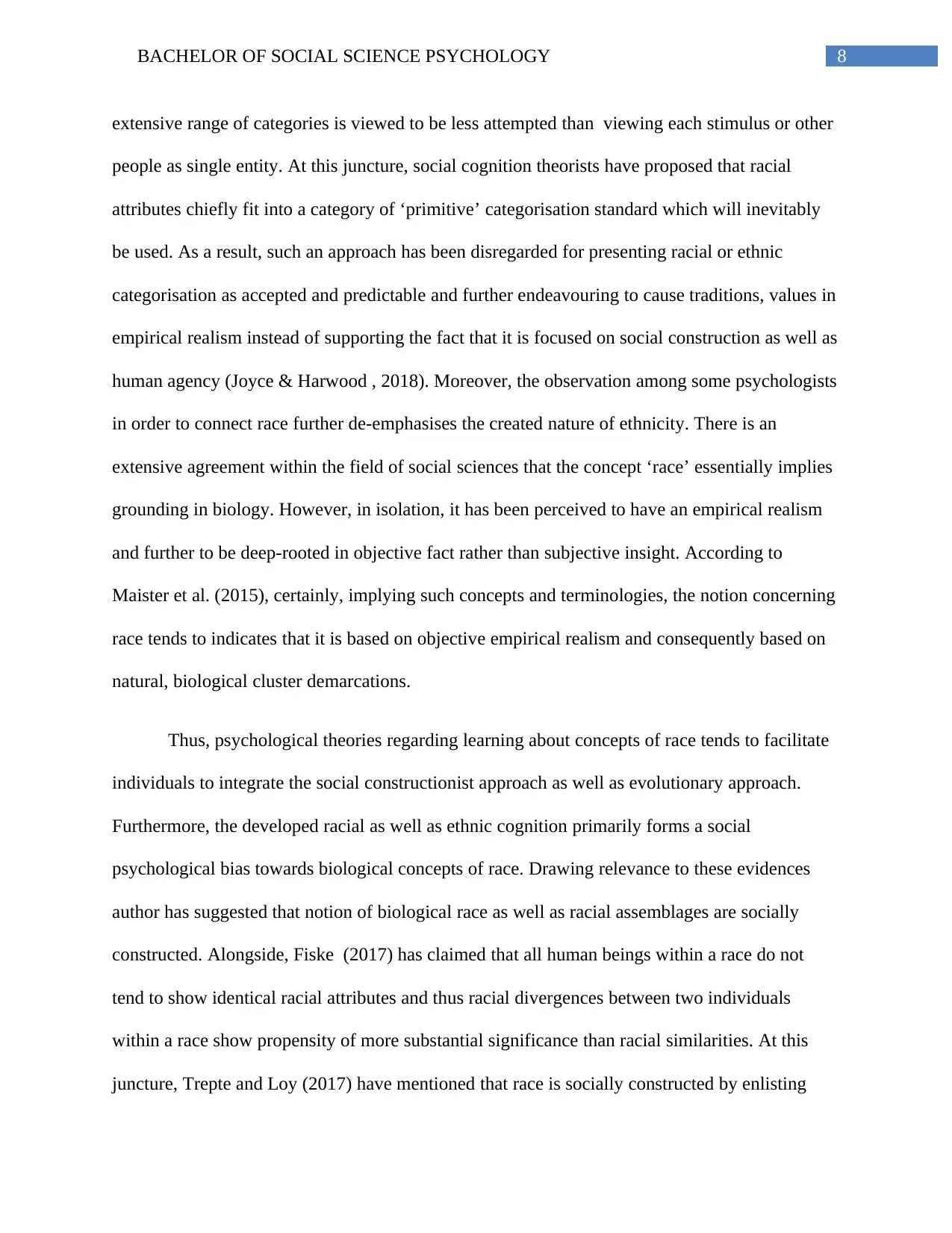
8BACHELOR OF SOCIAL SCIENCE PSYCHOLOGY
extensive range of categories is viewed to be less attempted than viewing each stimulus or other
people as single entity. At this juncture, social cognition theorists have proposed that racial
attributes chiefly fit into a category of ‘primitive’ categorisation standard which will inevitably
be used. As a result, such an approach has been disregarded for presenting racial or ethnic
categorisation as accepted and predictable and further endeavouring to cause traditions, values in
empirical realism instead of supporting the fact that it is focused on social construction as well as
human agency (Joyce & Harwood , 2018). Moreover, the observation among some psychologists
in order to connect race further de-emphasises the created nature of ethnicity. There is an
extensive agreement within the field of social sciences that the concept ‘race’ essentially implies
grounding in biology. However, in isolation, it has been perceived to have an empirical realism
and further to be deep-rooted in objective fact rather than subjective insight. According to
Maister et al. (2015), certainly, implying such concepts and terminologies, the notion concerning
race tends to indicates that it is based on objective empirical realism and consequently based on
natural, biological cluster demarcations.
Thus, psychological theories regarding learning about concepts of race tends to facilitate
individuals to integrate the social constructionist approach as well as evolutionary approach.
Furthermore, the developed racial as well as ethnic cognition primarily forms a social
psychological bias towards biological concepts of race. Drawing relevance to these evidences
author has suggested that notion of biological race as well as racial assemblages are socially
constructed. Alongside, Fiske (2017) has claimed that all human beings within a race do not
tend to show identical racial attributes and thus racial divergences between two individuals
within a race show propensity of more substantial significance than racial similarities. At this
juncture, Trepte and Loy (2017) have mentioned that race is socially constructed by enlisting
extensive range of categories is viewed to be less attempted than viewing each stimulus or other
people as single entity. At this juncture, social cognition theorists have proposed that racial
attributes chiefly fit into a category of ‘primitive’ categorisation standard which will inevitably
be used. As a result, such an approach has been disregarded for presenting racial or ethnic
categorisation as accepted and predictable and further endeavouring to cause traditions, values in
empirical realism instead of supporting the fact that it is focused on social construction as well as
human agency (Joyce & Harwood , 2018). Moreover, the observation among some psychologists
in order to connect race further de-emphasises the created nature of ethnicity. There is an
extensive agreement within the field of social sciences that the concept ‘race’ essentially implies
grounding in biology. However, in isolation, it has been perceived to have an empirical realism
and further to be deep-rooted in objective fact rather than subjective insight. According to
Maister et al. (2015), certainly, implying such concepts and terminologies, the notion concerning
race tends to indicates that it is based on objective empirical realism and consequently based on
natural, biological cluster demarcations.
Thus, psychological theories regarding learning about concepts of race tends to facilitate
individuals to integrate the social constructionist approach as well as evolutionary approach.
Furthermore, the developed racial as well as ethnic cognition primarily forms a social
psychological bias towards biological concepts of race. Drawing relevance to these evidences
author has suggested that notion of biological race as well as racial assemblages are socially
constructed. Alongside, Fiske (2017) has claimed that all human beings within a race do not
tend to show identical racial attributes and thus racial divergences between two individuals
within a race show propensity of more substantial significance than racial similarities. At this
juncture, Trepte and Loy (2017) have mentioned that race is socially constructed by enlisting
⊘ This is a preview!⊘
Do you want full access?
Subscribe today to unlock all pages.

Trusted by 1+ million students worldwide
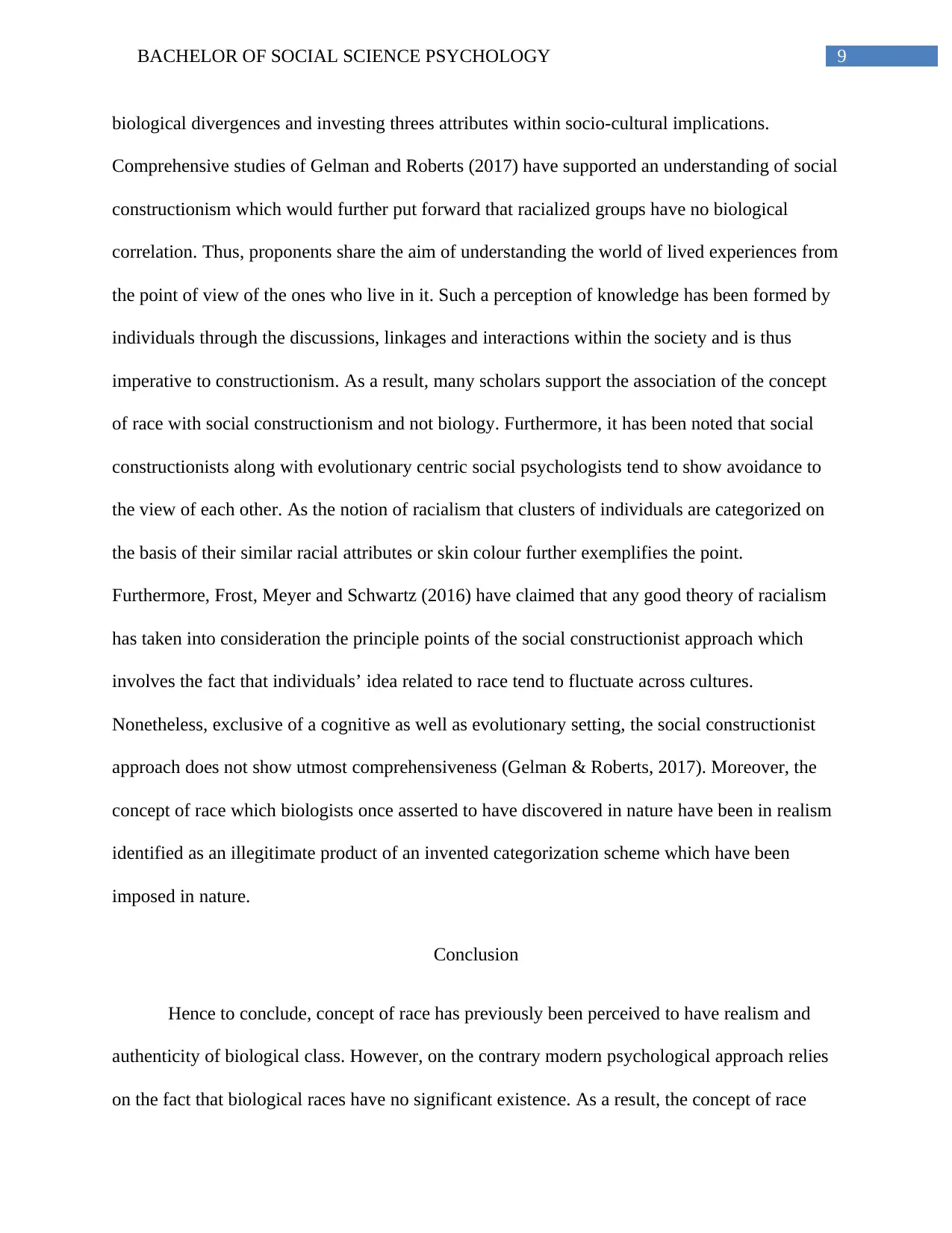
9BACHELOR OF SOCIAL SCIENCE PSYCHOLOGY
biological divergences and investing threes attributes within socio-cultural implications.
Comprehensive studies of Gelman and Roberts (2017) have supported an understanding of social
constructionism which would further put forward that racialized groups have no biological
correlation. Thus, proponents share the aim of understanding the world of lived experiences from
the point of view of the ones who live in it. Such a perception of knowledge has been formed by
individuals through the discussions, linkages and interactions within the society and is thus
imperative to constructionism. As a result, many scholars support the association of the concept
of race with social constructionism and not biology. Furthermore, it has been noted that social
constructionists along with evolutionary centric social psychologists tend to show avoidance to
the view of each other. As the notion of racialism that clusters of individuals are categorized on
the basis of their similar racial attributes or skin colour further exemplifies the point.
Furthermore, Frost, Meyer and Schwartz (2016) have claimed that any good theory of racialism
has taken into consideration the principle points of the social constructionist approach which
involves the fact that individuals’ idea related to race tend to fluctuate across cultures.
Nonetheless, exclusive of a cognitive as well as evolutionary setting, the social constructionist
approach does not show utmost comprehensiveness (Gelman & Roberts, 2017). Moreover, the
concept of race which biologists once asserted to have discovered in nature have been in realism
identified as an illegitimate product of an invented categorization scheme which have been
imposed in nature.
Conclusion
Hence to conclude, concept of race has previously been perceived to have realism and
authenticity of biological class. However, on the contrary modern psychological approach relies
on the fact that biological races have no significant existence. As a result, the concept of race
biological divergences and investing threes attributes within socio-cultural implications.
Comprehensive studies of Gelman and Roberts (2017) have supported an understanding of social
constructionism which would further put forward that racialized groups have no biological
correlation. Thus, proponents share the aim of understanding the world of lived experiences from
the point of view of the ones who live in it. Such a perception of knowledge has been formed by
individuals through the discussions, linkages and interactions within the society and is thus
imperative to constructionism. As a result, many scholars support the association of the concept
of race with social constructionism and not biology. Furthermore, it has been noted that social
constructionists along with evolutionary centric social psychologists tend to show avoidance to
the view of each other. As the notion of racialism that clusters of individuals are categorized on
the basis of their similar racial attributes or skin colour further exemplifies the point.
Furthermore, Frost, Meyer and Schwartz (2016) have claimed that any good theory of racialism
has taken into consideration the principle points of the social constructionist approach which
involves the fact that individuals’ idea related to race tend to fluctuate across cultures.
Nonetheless, exclusive of a cognitive as well as evolutionary setting, the social constructionist
approach does not show utmost comprehensiveness (Gelman & Roberts, 2017). Moreover, the
concept of race which biologists once asserted to have discovered in nature have been in realism
identified as an illegitimate product of an invented categorization scheme which have been
imposed in nature.
Conclusion
Hence to conclude, concept of race has previously been perceived to have realism and
authenticity of biological class. However, on the contrary modern psychological approach relies
on the fact that biological races have no significant existence. As a result, the concept of race
Paraphrase This Document
Need a fresh take? Get an instant paraphrase of this document with our AI Paraphraser
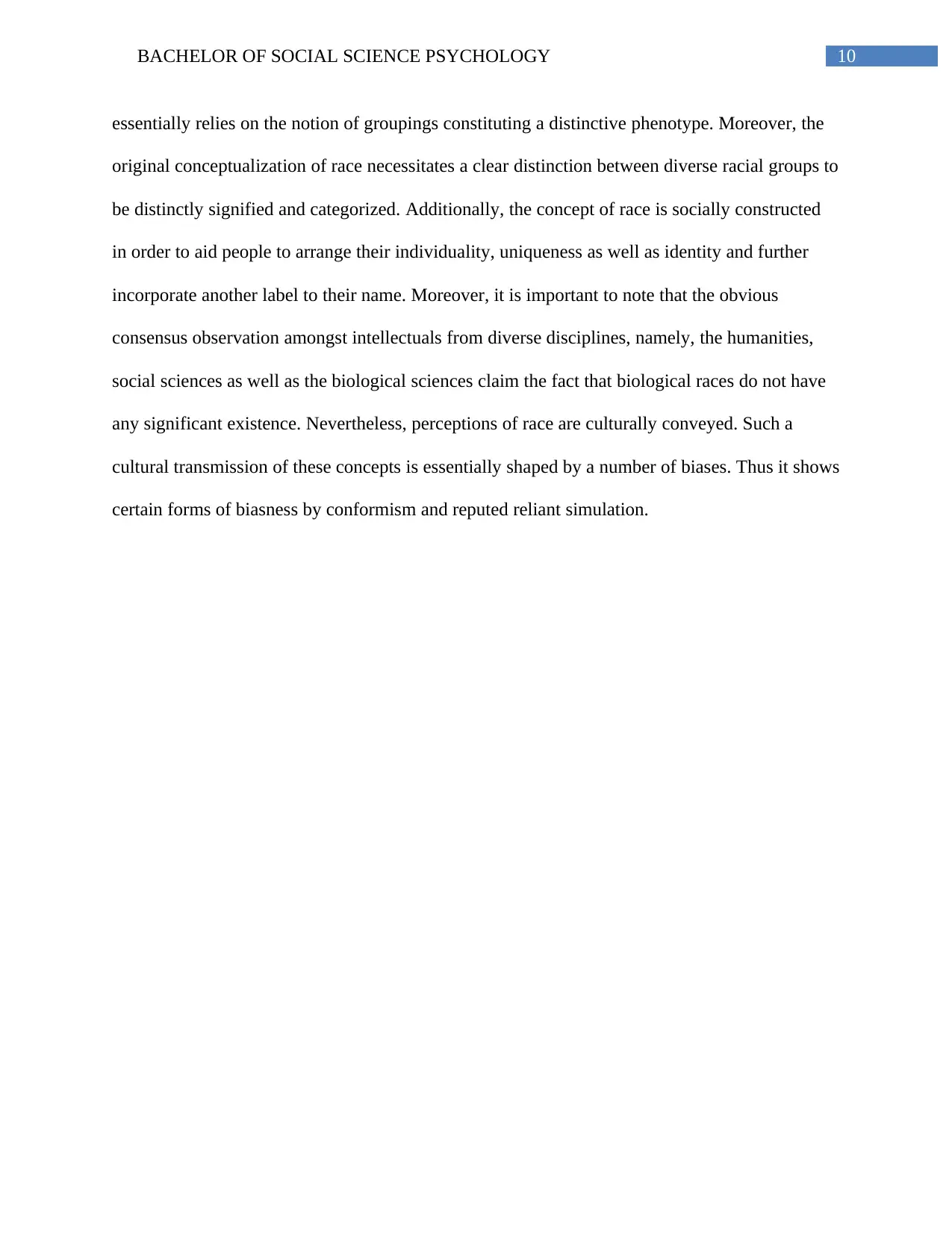
10BACHELOR OF SOCIAL SCIENCE PSYCHOLOGY
essentially relies on the notion of groupings constituting a distinctive phenotype. Moreover, the
original conceptualization of race necessitates a clear distinction between diverse racial groups to
be distinctly signified and categorized. Additionally, the concept of race is socially constructed
in order to aid people to arrange their individuality, uniqueness as well as identity and further
incorporate another label to their name. Moreover, it is important to note that the obvious
consensus observation amongst intellectuals from diverse disciplines, namely, the humanities,
social sciences as well as the biological sciences claim the fact that biological races do not have
any significant existence. Nevertheless, perceptions of race are culturally conveyed. Such a
cultural transmission of these concepts is essentially shaped by a number of biases. Thus it shows
certain forms of biasness by conformism and reputed reliant simulation.
essentially relies on the notion of groupings constituting a distinctive phenotype. Moreover, the
original conceptualization of race necessitates a clear distinction between diverse racial groups to
be distinctly signified and categorized. Additionally, the concept of race is socially constructed
in order to aid people to arrange their individuality, uniqueness as well as identity and further
incorporate another label to their name. Moreover, it is important to note that the obvious
consensus observation amongst intellectuals from diverse disciplines, namely, the humanities,
social sciences as well as the biological sciences claim the fact that biological races do not have
any significant existence. Nevertheless, perceptions of race are culturally conveyed. Such a
cultural transmission of these concepts is essentially shaped by a number of biases. Thus it shows
certain forms of biasness by conformism and reputed reliant simulation.
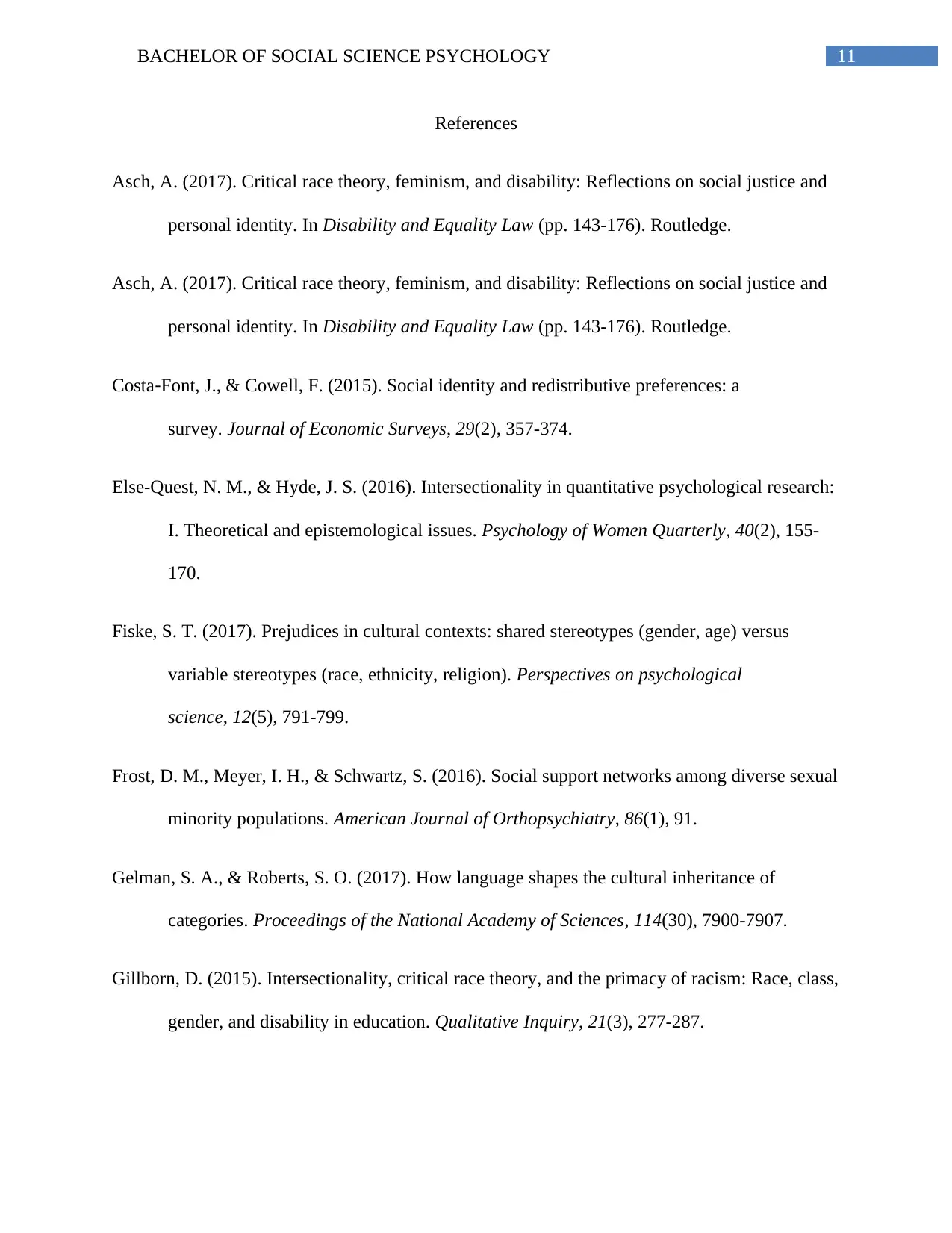
11BACHELOR OF SOCIAL SCIENCE PSYCHOLOGY
References
Asch, A. (2017). Critical race theory, feminism, and disability: Reflections on social justice and
personal identity. In Disability and Equality Law (pp. 143-176). Routledge.
Asch, A. (2017). Critical race theory, feminism, and disability: Reflections on social justice and
personal identity. In Disability and Equality Law (pp. 143-176). Routledge.
Costa‐Font, J., & Cowell, F. (2015). Social identity and redistributive preferences: a
survey. Journal of Economic Surveys, 29(2), 357-374.
Else-Quest, N. M., & Hyde, J. S. (2016). Intersectionality in quantitative psychological research:
I. Theoretical and epistemological issues. Psychology of Women Quarterly, 40(2), 155-
170.
Fiske, S. T. (2017). Prejudices in cultural contexts: shared stereotypes (gender, age) versus
variable stereotypes (race, ethnicity, religion). Perspectives on psychological
science, 12(5), 791-799.
Frost, D. M., Meyer, I. H., & Schwartz, S. (2016). Social support networks among diverse sexual
minority populations. American Journal of Orthopsychiatry, 86(1), 91.
Gelman, S. A., & Roberts, S. O. (2017). How language shapes the cultural inheritance of
categories. Proceedings of the National Academy of Sciences, 114(30), 7900-7907.
Gillborn, D. (2015). Intersectionality, critical race theory, and the primacy of racism: Race, class,
gender, and disability in education. Qualitative Inquiry, 21(3), 277-287.
References
Asch, A. (2017). Critical race theory, feminism, and disability: Reflections on social justice and
personal identity. In Disability and Equality Law (pp. 143-176). Routledge.
Asch, A. (2017). Critical race theory, feminism, and disability: Reflections on social justice and
personal identity. In Disability and Equality Law (pp. 143-176). Routledge.
Costa‐Font, J., & Cowell, F. (2015). Social identity and redistributive preferences: a
survey. Journal of Economic Surveys, 29(2), 357-374.
Else-Quest, N. M., & Hyde, J. S. (2016). Intersectionality in quantitative psychological research:
I. Theoretical and epistemological issues. Psychology of Women Quarterly, 40(2), 155-
170.
Fiske, S. T. (2017). Prejudices in cultural contexts: shared stereotypes (gender, age) versus
variable stereotypes (race, ethnicity, religion). Perspectives on psychological
science, 12(5), 791-799.
Frost, D. M., Meyer, I. H., & Schwartz, S. (2016). Social support networks among diverse sexual
minority populations. American Journal of Orthopsychiatry, 86(1), 91.
Gelman, S. A., & Roberts, S. O. (2017). How language shapes the cultural inheritance of
categories. Proceedings of the National Academy of Sciences, 114(30), 7900-7907.
Gillborn, D. (2015). Intersectionality, critical race theory, and the primacy of racism: Race, class,
gender, and disability in education. Qualitative Inquiry, 21(3), 277-287.
⊘ This is a preview!⊘
Do you want full access?
Subscribe today to unlock all pages.

Trusted by 1+ million students worldwide
1 out of 14
Related Documents
Your All-in-One AI-Powered Toolkit for Academic Success.
+13062052269
info@desklib.com
Available 24*7 on WhatsApp / Email
![[object Object]](/_next/static/media/star-bottom.7253800d.svg)
Unlock your academic potential
Copyright © 2020–2025 A2Z Services. All Rights Reserved. Developed and managed by ZUCOL.





